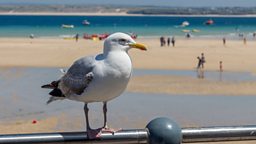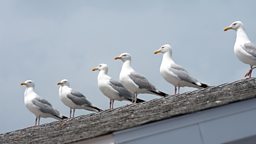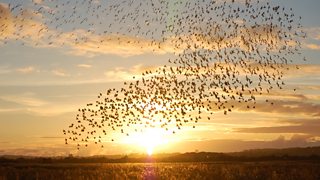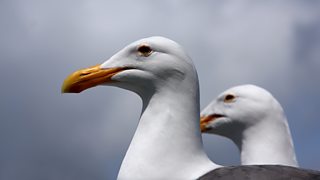Seagull urban myths: fact or fiction?
If you’re heading off on your British beach holiday then there may be one thing you’re even more nervous about than inclement weather – the ravenous seagull.
In some parts of the country this large, loud, boisterous bird will steal the ice cream out from under your nose. And there are numerous other urban myths surrounding the sea bird and its Hitchcockian behaviours. But are any of them true?

-
![]()
Salt on Your Tongue
Charlotte Runcie shows how the sea has inspired and terrified us through the ages.
1. Seagulls will steal the food out of your mouth
If you’re buying a tasty lunch from the beach café and plan to saunter back to your spot on the sand to eat it – beware the insatiable, swooping seagull! Many of us have had a chip taken right from our hand or the ice cream plucked from its cone by an over-zealous bird. But has anyone had food snatched from their actual jaws? Well, apparently the answer is yes.
Cut lips and tongues are among the injuries reported to have been caused by gulls. “We have even seen adults and young children with cuts around and inside their mouths as well as their hands where sneaky seagulls have swooped down to take their food,” reported Claire Field, a community pharmacist based in Cornwall.
Don’t think because you’re already biting into your sarnie it's safe…
How the seagull moved to the cities

Brett Westwood follows gulls away from the sea and explores how they thrive in cities.
2. Seagulls are more likely to attack redheads
Rumour has it that people with red hair are more likely to find themselves being dive-bombed by the bird than brunettes and blondes. Is there anything in it?

We do know that gulls have excellent colour vision. On top of that, adult gulls have a red spot on the underside of their beaks so their chicks know where to peck to get them to regurgitate food. It would make sense, therefore, for gulls to associate red with meal times and be drawn to the colour.
However, one man in the Scottish fishing port of Arbroath would argue otherwise. Community councillor Ian Watson found that gulls wouldn’t touch the remnants of his daughter’s crimson, Man United themed cake when he threw it out for the birds.
Curious, he got some red panelling and covered it in bread. Again, the gulls stayed away, though they’d happily eat the scraps off a black surface. Due to Watson’s findings, Angus council decided to paint red patches near rubbish bins, to deter the birds. The experts remain sceptical however with a spokesperson from the RSPB stating, “We can't see any scientific reason why seagulls would be deterred by the colour red.”
Of course, when we talk about red hair we actually mean auburn, ginger, or strawberry blonde – not crimson at all. Looks like the jury's out on this one…
3. Seagulls attack small pets
In July 2019, a gull allegedly snatched a four-year-old chihuahua called Gizmo from a garden in Devon. The dog’s owner, 24-year-old Becca from Paignton, reported how her partner was in the garden hanging the washing out and witnessed the gull “swoop down.” She told Devon Live how “it carried Gizmo a fair way as we couldn’t see him anymore. I have no idea if he was dropped or where he is now.”
In 2015, Cornish seagulls attacked a Yorkshire terrier whose wounds were so extensive, he had to be put down. Roo’s owner Emily said the garden where he was attacked “was like a murder scene”.
And that same year a 20-year-old tortoise called Stig died after being flipped upside down and pecked by a flock of gulls. His owner Jan said the attack on her pet was “like a scene from a horror movie”.
This one, sadly, is certainly true. However, a spokesperson from the RSPB says, “fortunately these types of incidents are very rare and not typical gull behaviour.”

-
![]()
Could these seven reasons make you love seagulls?
In the defence of the controversial seabird.
4. Seagulls eat each other
We know that seagulls attack and eat pigeons and other birds, but do they really feed on each other? The macabre answer is yes.
Many fledglings are snatched from their nests by these predatory gulls – and some are even gobbled down by their own parents.
Studies carried out in Herring Gull colonies have found that many chicks are attacked and killed after foolishly wandering into neighbouring territories, with their corpses then being eaten by members of the colony. However, there are adult Herring Gulls that will leave their own patch specifically in search of an unsuspecting chick to be their next meal. Many fledglings are snatched from their nests by these predatory gulls – often young, single males – and some are even gobbled down by their own parents. In fact, few visitors to Herring Gull colonies have failed to record examples of cannibalism.
Seagulls do, it seems, eat each other.
5. Seagulls will explode if they eat Alka-Seltzer
There’s a long-held belief that if you feed a seagull an indigestion tablet, they will violently explode in a ball of feathers. The alleged science behind this theory is that seagulls are unable to pass wind, and the indigestion remedy therefore causes a volatile build-up of gases in the seagull’s stomach.
However, there’s a major flaw in this pseudo-science. A bird’s diet may not require them to pass wind, but this doesn’t mean they aren’t equipped to do so. Also, gulls are experts at regurgitating their food, and could easily evict an Alka-Seltzer from the stomach if they found themselves in discomfort.
Consider this myth well and truly busted.
Which bird sings the most songs?

Birdsong expert and sound recordist Don Kroodsma reveals which bird he thinks sings the most songs.
More from Radio 4
-
![]()
Windbreakers, Sea Eagles and Anthrax
Poet Richard Price relives his childhood summer holidays on a beach in the northwest highlands.
-
![]()
Natural Histories: Gull
Brett Westwood follows gulls away from the sea and finds them thriving in the urban environment and at landfill sites .
-
![]()
Tweet of the Day: Herring Gull
Steve Backshall presents the herring gull.
-
![]()
Gull Wars
Tackling seagull violence.






